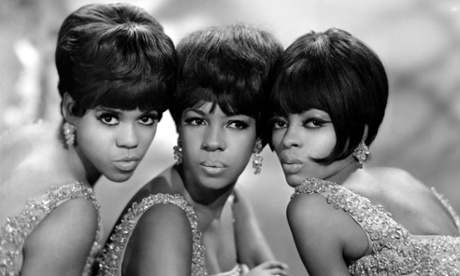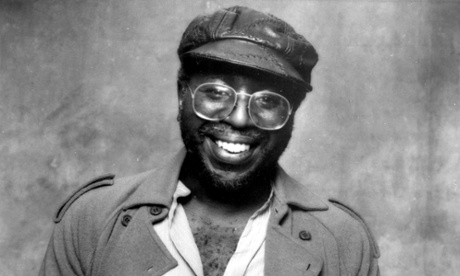1. The Rotary Connection – I Am the Black Gold of the Sun
Gifted with a five-octave vocal range, Chicago-born Minnie Riperton was plucked from an a cappella choir to sing with girl-group the Gems, who found little success under their own name but scored work as session backing-vocalists for the Dells, Etta James and Fontella Bass. Her first real break came, however, when Marshall Chess – son of Leonard, founder of legendary blues label Chess Recordings – assembled the Rotary Connection in 1967. They were a multi-racial collective who played baroque soul, out-there funk and billowing, symphonic psychedelia, and specialised in radical reworkings of then-popular hits. In truth, the Connection were often better in concept than practice, and much of their material sounds today like relics from the age of Aquarius, though their takes on the Rolling Stones’ Lady Jane and Aretha’s Respect are impressive, while their own Memory Band, a dippy showcase for Minnie, gave the world the sitar lick that runs through Bonita Applebum. Their finest track, I Am the Black Gold of the Sun, was an ambitious work of afro-mysticism off their final album, 1971’s Hey, Love. While Riperton played second-fiddle to singer Dave Scott, her otherworldly backing vocals lend this epic slow-build of a track an magic that still thrills today.
2. Les Fleurs
Riperton was just one voice among many within the Rotary Connection, but Charles Stepney – the producer/arranger who’d helped Chess assemble the group, and would later produce platinum albums for Earth, Wind & Fire before dying of a heart attack in 1976 – recognised her potential. Aided by songwriter Richard Rudolph – who’d co-written Black Gold and was Riperton’s lover (and, later, husband) – Stepney wrote, produced and arranged Riperton’s solo debut Come to My Garden, a magnificent set that cut away the self-indulgence that marred much of the Connection’s work, but preserved that group’s effervescent psychedelic sensibility, and billowing, orchestral magnificence. Opening track Les Fleurs found Riperton imagining herself a flower budding into bloom, a hippy-dippy metaphor for every soul realising its true potential. Stepney’s production echoed that metaphor, its sparse guitar and drum verse blossoming into wonderfully overblown choruses encompassing swooning strings, blaring horns, artfully arranged choirs and Riperton’s own theremin-rivalling whistle-register scree; the entire track is some winningly over-egged pudding, its absurdity part of its charm. Though it was overlooked on release, drum’n’bass adventurers 4hero’s faithful reworking for their 2001 album Creating Patterns won a belated new audience for the Riperton original.
3. Whenever Wherever
While nothing else on Come to My Garden quite equalled the glorious overload of Les Fleurs, the album’s other nine tracks were of a dulcet, diaphanous piece: Completeness’s stirring ode to perfect love (“Rapture, loving, needing, pleasing, sharing, caring”); the angelic Memory Band, a fairytale set to bossa nova pulse; Close Your Eyes and Remember’s aching nostalgia for a time “when the moon was made of cheese”. Best of them was this closing track, which hit the finest balance between Riperton’s Dionne Warwick/Burt Bacharach ambitions, and Stepney’s own grandiose vision. The verses set Riperton’s overwhelmed sighs to soaring strings (“Your touch is all that I need,” she croons, lost in romance); the choruses, meanwhile, were baroque staccato fusillades set to proggy time signatures a quantum physicist couldn’t untangle. Together, their unlikely combination made for a delicious confection, teetering gracefully like a gargantuan, multi-tiered wedding cake.
4. Perfect Angel
Come to My Garden stiffed on release, so Riperton made a retreat to backing-singer status, moving to Los Angeles to join Wonderlove, who accompanied Stevie Wonder as he took the synth-driven symphonies of his 70s purple patch out on the road. Wonder soon recognised the singular talent within his ranks, and went on to produce her second solo album Perfect Angel in 1974 (under the pseudonym El Toro Negro, and accompanied by his studio collaborators Malcolm Cecil and Robert Margouleff); he also contributed two songs: the psychedelic slow-burn of Take a Little Trip, and this sun-dappled title track. Wonder’s discography was studded with ebullient paeans to the perfect love, a subject close to Riperton’s own heart, and Perfect Angel was another such triumph; the unforced and infectious joy of Riperton’s acclamations, in concert with the track’s jazzy playfulness, ensured her Perfect Angel was giddy and charming, rather than saccharine or soppy.
5. Lovin’ You
The album’s breakthrough track happened almost by accident, its genesis lying in a melody Riperton would sing as a lullaby to her baby daughter. For its smartly spare production, Wonder added some dizzy electric piano and a cradle of gentle acoustic guitar, but mostly ceded the foreground to Riperton’s remarkable vocal, which swung effortlessly through the five octaves at her disposal, no mere exercise in showing off her impressive range, but the sound of Riperton luxuriating in joy. It was an era when female soul singers were often given to aural excitation, from Donna Summer’s Love to Love You Baby to Diana Ross’s Love Hangover, but it is notable that – one clunky moment of suggestiveness aside (“Every time that we … ooh!”, coos Riperton, with all of the eroticism of a Benny Hill skit) – Minnie’s delirious devotionals here seemed less inspired by lust than the deeper emotions awoken by motherhood. You could easily read her words as a message from one lover to another, but as the album version begins its exit fade, Riperton begins to sing “Maya, Maya, Maya, Maya,” just as she used to sing it to a two-year-old Maya Rudolph.
6. Reasons
While much of Perfect Angel mused upon matters of the heart – from the breathy lust of Every Time He Comes Around to the purer maternal devotion of Lovin’ You – Riperton was still enough of a flower child to touch upon matters spiritual, as she did with the album’s opening track. A lush fusion of limber funk and lithe rock, set to a fluidly jazzy shuffle, Reasons was a joyous exercise in existential autobiography, as Riperton seeks to locate the meaning of life among myriad distractions. Perhaps unsurprisingly, it’s music that powers her along, and indeed, for Riperton, the act of singing is a revelation in of itself, an opportunity to connect with a higher power: “Oh, the sweet delight, to sing with all my might,” she croons, “to spark the inner light, of wonder burning bright.” And at that moment, scored by lucid, liquid lead lines from Stevie Wonder’s favoured guitarist, Michael Sembello, Riperton fires up her whistle tone and holds it long enough to leave the Bill Withers of Lovely Day slack-jawed in envy at her lung-capacity and lyrical grace.
7. Our Lives
By the time of Perfect Angel, Riperton had lost interest in the tempestuous affairs, adolescent dramas and ecstatic agonies that often dominate pop. In Richard Rudolph she’d found the love of her life; the chase that is the subject of so many jukebox hits was over for her, and what makes the album remarkable is how much passion and profundity she could draw from everything that comes after the “happy ending” most pop sees as its conclusion. These songs were adult, complex, though still joyful: The Edge of a Dream blended the space cadet poetics of Come to My Garden with Lovin’ You’s parental theme; It’s So Nice (to See Old Friends) celebrated the simple pleasure of getting stoned and reconnecting with loved ones. Our Lives, meanwhile, closed the album with a dream of Riperton and Rudolph’s future together, a vision of domestic bliss, of days “filled by the light of children’s laughter”, of nights “touched by the glow of lovers’ songs”. Miraculously, the track avoids any threat of schmaltz: Riperton’s vocals have never sounded so beautiful, while Wonder adds some tender, elegiac harmonica. The song is doubtless lent an unforeseen poignancy, however, by the tragic events that were to befall Riperton in the years that followed.
8. Feelin’ That Your Feelin’s Right
A couple of months after Lovin’ You topped the Billboard Top 100, taking Perfect Angel to No 4 in the album charts, Riperton delivered her follow-up album. Stevie Wonder was busy working on his epic Songs in the Key of Life, so Riperton and Rudolph shared production duties on Adventures in Paradise with Stewart Levine, best known for his work with soul-jazz stalwarts the Crusaders, whose Larry Carlton and Jim Gordon played on the new album. The result swapped out Perfect Angel’s psych-funk edges for a smoother, jazzier sound, and though the lack of a Lovin’ You-style hit prevented Adventures in Paradise matching the success of a predecessor, Levine’s elegant grooves proved a fine match for Riperton’s extraordinary vocal, especially on this slinky glide, which accompanies Minnie with plush strings, dreamy Rhodes piano and blissed-out saxophone; indeed, much of Adventures in Paradise presages the luxuriant metropolitan sass of the Crusaders’ 1979 pop crossover hit with Randy Crawford, Street Life.
9. Inside My Love
Throughout Adventures in Paradise, Riperton interwove spirituality and carnality with grace and maturity. Most explicit was this languid groove, blurring the lines between physical and spiritual communion in a tale of “two people, just meeting … two strangers, not strangers”. Over melting Fender Rhodes chords and deftly swelling strings, Riperton taps the mystery and power of an attraction that’s more than simply physical, but also crucially – and unabashedly – physical. “We should be one inside each other,” she beckons, and again lust and another, more elevated connection are commingled: “You can see inside me,” she notes, adding, by invitation, “You can come inside me.” Steamy stuff – but Riperton’s ability to combine the erotic with metaphysical and emotional layers lends a welcome depth to Inside My Love’s double (and sometimes single) entendres. The eerie magic of its slow-burning quiet storm, meanwhile, was later sampled by everyone from Tupac and A Tribe Called Quest to Aaliyah.
10. Memory Lane
Adventures in Paradise’s follow-up, 1977’s Stay in Love: A Romantic Fantasy Set to Music, saw Minnie follow her contemporaries towards the disco dancefloor, but despite a fresh collaboration with Stevie Wonder, the album didn’t convince. You could forgive Riperton and Rudolph for taking their eye off the game. Early in 1976, Minnie had been diagnosed with breast cancer, undergoing a mastectomy; after the surgery, doctors predicted she only had six more months to live. Riperton went on to speak bravely and publicly about her disease, becoming a spokesperson for the American Cancer Society (and recording a heartbreaking commercial promoting breast examination), and continuing to perform and record. Her fifth album, Minnie, arrived in May 1979, including another Stevie Wonder song (the ebullient Lover & Friend), a slinky cover of Light My Fire with José Feliciano, and a seven-year-old Maya Rudolph singing backup on Dancin’ and Actin’ Crazy. The highlight, however, is Memory Lane; bittersweet, it played Riperton as a broken-hearted lover, lost in her memories and thoughts of what-could-have-been. Typical love-song fare, perhaps, but when Riperton visited American chatshow host Mike Douglas’s show to perform Memory Lane in June 1979, the juxtaposition of superimposed photos of Riperton with her husband and young children, and Riperton, in a noticeably weakened, ailing state, singing “I don’t wanna go … Save me, save me”, lent the song’s tale of regret new, poignantly elegiac meaning. Riperton succumbed to her cancer a month later. “She did not get her due recognition in her lifetime,” Wonder said, on a tribute episode of Soul Train filmed shortly after her death. “For as long as she lived, she lived,” he added, “full of very beautiful sounds, very positive energies. I was fortunate to meet someone so perfect that she deserved to be called a Perfect Angel. And she was, and will always be in our hearts.”
- This article was amended on 30 June to replace the track Ordinary Pain, on which Minnie Riperton did not in fact sing lead.











